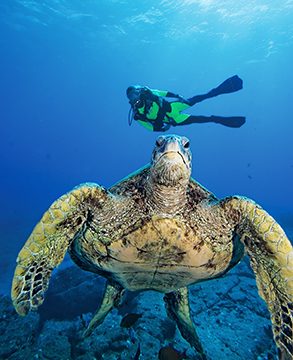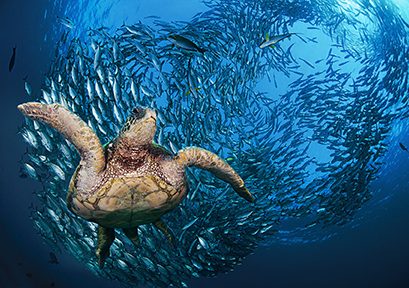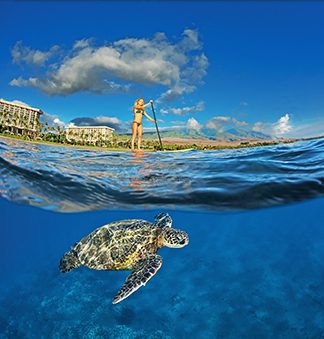Tips for photographing sea turtles
THE ANCESTORS OF MODERN SEA TURTLES shared the oceans with ichthyosaurs and plesiosaurs during the late Jurassic period 150 million years ago. Their descendants now inhabit reefs and oceans around the world. All seven species of sea turtles — the flatback, green, hawksbill, leatherback, loggerhead, Kemp’s ridley, and olive ridley sea turtles — are listed as endangered or threatened under the Endangered Species Act.

Like their land-based relatives, they evolved to have their bony outer shells. The top is known as the carapace, and the underside, which is generally lighter in color, is the plastron. Scutes — large, scalelike plates made of keratin, the same substance as human fingernails and horse hooves — cover both bone layers. The leatherback is the only exception, having a leathery skin over its more flexible carapace.
Depending on where you dive, one species will be more common than others. In my backyard in Hawai‘i you can encounter 100 to 200 green sea turtles for every hawksbill turtle. In the Philippines you typically have an even chance of seeing one or the other. People in some areas of Indonesia still eat sea turtles despite their endangered status and prohibitions against consuming them. Recognizing you as a predator, your photographic subject can make it challenging to get close enough to capture an image of a turtle in these areas. Around the island of Sipadan in Malaysia, however, sea turtles come to mate and have enjoyed protected status for many years. Scuba divers also converge here, and the turtles are used to their presence.
A diver swims near a green sea turtle (Chelonia mydas) in Kauai, Hawai‘i. DAVID FLEETHAM

Other good locations to photograph turtles include Costa Rica, the Bahamas, Florida, Australia, Mexico, and Egypt. Whether you’re staying at a resort or on a liveaboard, ask your guides for dive sites with frequent turtle encounters. Protection laws vary from country to country, so be sure to inquire at your destination for specific rules. Regardless, be respectful of these wild animals, and avoid any interactions that cause stress. Even when photography is your purpose, take a moment to take away your mask from your camera to observe and appreciate these magnificent creatures.
A green sea turtle glides below a school of jacks off Bali, Indonesia. DAVID FLEETHAM

Sea turtles of all species are independent characters with individual peculiarities you will need to determine to make the most of a photographic opportunity. If a turtle 50 feet away lifts off the reef and swims away from you, take a deep breath, exhale, and look for another subject. This one is not your turtle, and even if you try, you won’t catch a turtle that does not want to be caught. Although relatively slow for sea creatures, most turtles can swim faster and further than humans.
If a turtle does not swim away, approach it slowly, and stop about 10 feet away. If at any point it begins to rise with a push from its front fins, stop and wait for it to settle back down. Even though you’ll be too far away for your strobes to have any effect, take a shot or two, and look for a reaction. If it doesn’t react, this is your turtle. Inch your way closer, frequently stopping to hit the shutter and check on your subject.
This green sea turtle glides below surf instructor Tara Angioletti on a stand-up paddleboard off Canoe Bearch, Maui. Hawai‘i.
DAVID FLEETHAM

Some turtles will be curious to the point of putting their nose on your dome port to examine their strange, distorted reflection staring back at them. Recurring blasts of light from your strobes will eventually affect a turtle attempting to rest, so be kind by limiting the number of photos you take and pulling the trigger only when you have the angle you want.
All turtles will eventually swim toward the surface for a breath of air or along the reef. The time between breaths varies with their activity. They will surface every few minutes when feeding but can stay up to two hours underwater while resting. If they swim up, don’t block their passage. If they have put up with you so far, you can likely swim beside them and snap pictures as you go. Time the tempo of their front flippers to get the appropriate angle. If your subject is willing, keep pushing your shutter release. It is surprising how different turtles can look depending on the position of their fins and the angle of the image. Generally, looking back from slightly ahead of your subject is the most desirable angle.
A green sea turtle surfaces for a breath off the coast of Maui. DAVID FLEETHAM

If the turtles surface, wait below and watch them. Turtles are keenly aware of their vulnerability to predation while on the surface, and few individuals will put up with a photographer. Between breaths the turtles will put their heads back in the water and look down to check their surroundings for any danger. Turtles are well acquainted with their home reef and will often return to where you initially saw them, so wait there.
An upward angle of a swimming turtle will allow you to get a bluewater background, but be careful with your strobe’s power setting. A turtle’s underside can be very reflective. When you are below a turtle, consider turning off your strobes and shooting a silhouette. Increase your shutter speed, and maneuver yourself so the turtle is eclipsing the sun. The faster shutter speed can produce wonderful beams of light, and you can push the shutter over and over or even switch to a drive setting since you don’t have to wait for the strobe to recycle. It is surprising how much light can change in a split second.
If your turtle is cruising along the reef, try capturing an image of its top shell from above. Downward angles are generally frowned upon in underwater photography circles, but with the right punch of strobe you can get a memorable shot. Shells can vary depending on how clean they are, and the immaculate ones are spectacular.
A female will travel hundreds and even thousands of miles to the beach where she was born, and males will follow females to mate before the mother deposits the eggs into a hole she excavates in the sand. During these open-ocean journeys, the shells can pick up algal growth and even barnacles. You can occasionally see turtles rubbing their plastrons on coral, rubble, or a sand bottom to scrub them clean.
To get an unblemished shell, turtles visit cleaning stations on the reef, where surgeonfish, wrasses, and butterflyfish will nibble on growth that has accumulated. The cleaning stations can offer amazing photographic opportunities. You can sometimes find dozens of turtles amenable to bubble-blowing photographers. The schools of fish cleaning the turtles, however, are less welcoming. Once again, patience is the key. Find the distance where the cleaners do not abandon their task.
It is often exhalation noise that causes the disturbance, so if you are going to try to get closer, you may want to briefly hold your breath (ensuring you do not ascend while doing so). Inch in, get your shots, and then move back to a safe distance before you breathe. Wait there while you catch your breath, and then repeat. A rebreather is ideal for these situations.
When groups of turtles gather, there are often one or two troublemakers. I have seen them surface for a breath and return to the location they vacated only to find another turtle has taken up residence. Some turtles will take this in stride and look for another spot, but others will make their displeasure known by landing on the trespasser and even nipping at their fins to reclaim their coveted position on the reef. When a conflict is happening, turtles will often ignore a photographer.
Turtles are often so focused on the task of feeding that you can have a closer encounter. Be aware of their demeanor as you approach, and take your time so they can trust your intentions. Feeding hawksbills are wonderful subjects for images and even more so for video. They will often move rocks and coral to get to the right sponge, allowing you to see them crunch into a meal using their extremely long necks and birdlike beaks. Green sea turtles, on the other hand, have a less protrusive mouth with a serrated jaw for their herbivore diet.
There is no wrong lens for photographing sea turtles, but a wide-angle zoom lens is most photographers’ go-to choice. In many locations it is happenstance to encounter a turtle, so you can make it work with whatever lens you have. I have shot turtle face portraits with a 100mm macro lens and used a full-frame fisheye lens to capture reef scenes that include a turtle. A fisheye lens tends to distort the turtle the closer you get, so pay attention to your composition when using one.
Sea turtles are beautiful subjects. They continue to navigate an environment that’s increasingly threatened by changes to our planet. Risks to their populations include loss of habitat, fishery bycatch, plastic waste, and illegal trade in their eggs, meat, and shells. Treat them respectfully, and they will deliver exceptional images to delight you and your audience.
With your photos you can share the story of these fascinating ancient mariners and their journey of survival. AD
© Alert Diver — Q4 2022